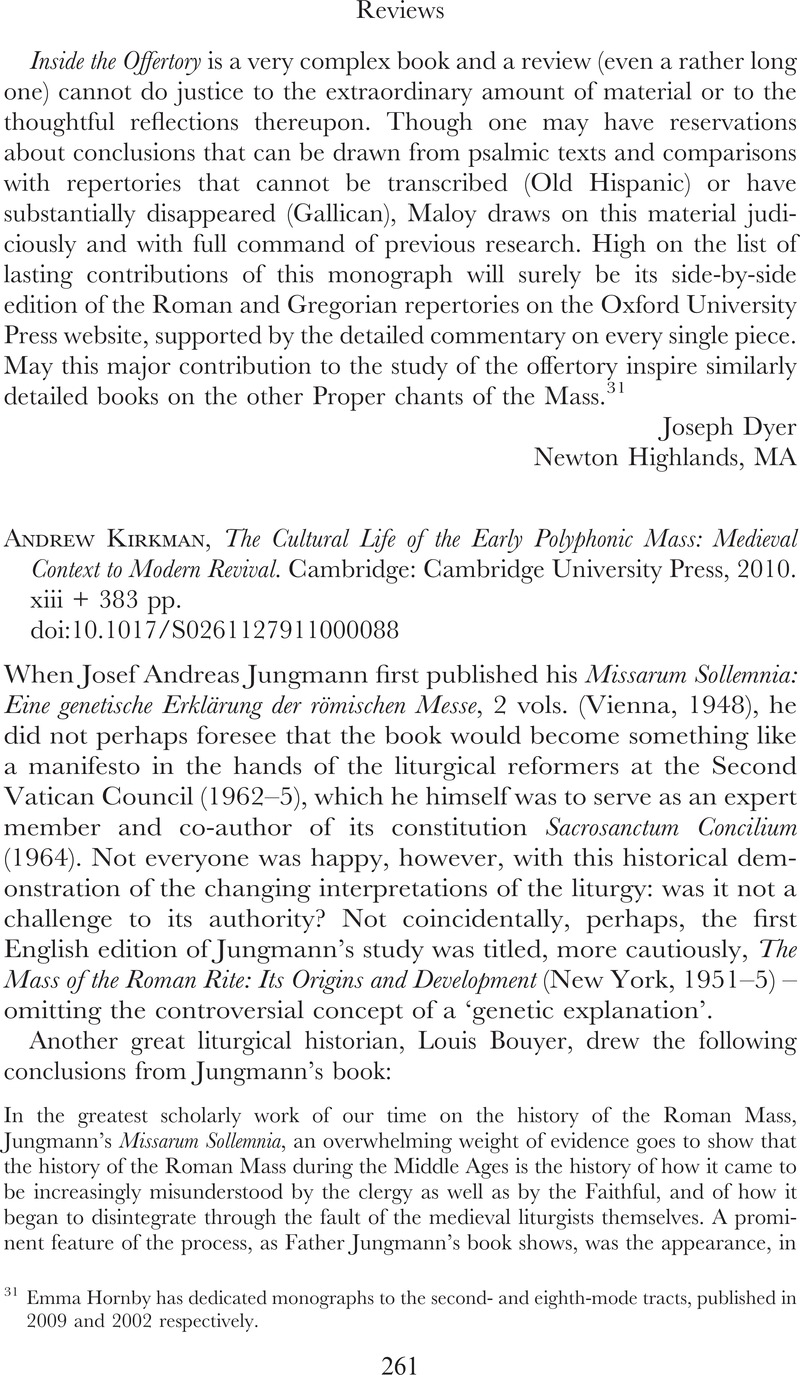No CrossRef data available.
Article contents
Andrew Kirkman, The Cultural Life of the Early Polyphonic Mass: Medieval Context to Modern Revival. Cambridge: Cambridge University Press, 2010. xiii + 383 pp.
Published online by Cambridge University Press: 08 September 2011
Abstract

- Type
- Reviews
- Information
- Copyright
- Copyright © Cambridge University Press 2011
References
1 Bouyer, L., The Liturgical Piety (Notre Dame, Ind., 1955), p. 16Google Scholar .
2 McLuhan, M., The Gutenberg Galaxy: The Making of Typographic Man (London, 1962), pp. 137–138Google Scholar .
3 Bouyer, The Liturgical Piety, p. 80.
4 Gombrich, E. H., ‘In Search of Cultural History’, in id., Ideals and Idols: Essays on Values in History and in Art (Oxford, 1979), pp. 25–59Google Scholar .
5 Kirkman, A., ‘The Invention of the Cyclic Mass’, Journal of the American Musicological Society, 54 (2001), pp. 1–47CrossRefGoogle Scholar .
6 This terminology has been adopted in Wagner, P., Geschichte der Messe (Leipzig, 1913)Google Scholar .
7 For the ‘Confrérie de la messe de Nostre-Dame’ at Tournai cathedral and an endowment for their performances (1349–50), see Strohm, R., Music in Late Medieval Bruges (rev. edn., Oxford, 1990), pp. 102 and 259Google Scholar ; La Messe de Tournai, ed. Dumoulin, J., Huglo, M., Mercier, P. and Pycke, J. (Tournai, 1988)Google Scholar , introduction.
8 See Strohm, R., ‘Einheit und Funktion früher Meßzyklen’, in Dubowy, N. and Meyer-Eller, S. (eds.), Festschrift Rudolf Bockholdt zum 60. Geburtstag (Pfaffenhofen, 1990), pp. 141–160Google Scholar ; repr. in Brzoska, M. (ed.), Die Geschichte der musikalischen Gattungen (Laaber, 2006), pp. 99–116Google Scholar .
9 See Robertson, A. W., Guillaume de Machaut and Reims: Context and Meaning in his Musical Works (Cambridge, 2002), pp. 257–275Google Scholar .
10 Important new research by Birgit Lodes is not considered. See, for example, her ‘“Maria zart” und die Angst vor Fegefeuer und Malafrantzos – Die Karriere eines Liedes zu Beginn des 16. Jahrhunderts’, in Schwindt, N. (ed.), Musikalischer Alltag im 15. und 16. Jahrhundert (Trossinger Jahrbuch für Renaissancemusik, 1; Kassel, 2001), pp. 99–133Google Scholar .
11 See Nitschke, W., Studien zu den Cantus-firmus-Messen Guillaume Dufays (Berlin, 1968), pp. 370–374Google Scholar , with cantus firmus examples in Tabelle 8. San Gottardo was a patron saint of Lombardy and the Sforzas.
12 The cited passage in Fallows, D., Dufay (London, 1982), pp. 165–168Google Scholar , introduces the name because of the musical overlaps with the composer's own chanson Resveillés vous.
13 The Mass belonged to an endowment for the feast of Our Lady of the Snow (5 August) made by the composer during his lifetime (not as part of the testament), probably 1472: see Strohm, R., The Rise of European Music, 1380–1500 (Cambridge, 1993), pp. 284–286Google Scholar .
14 Bowers, R., ‘Obligation, Agency and Laissez-faire: The Promotion of Polyphonic Composition for the Church in Fifteenth-Century England’, in Fenlon, I. (ed.), Music in Medieval and Early Modern Europe (Cambridge, 1981), pp. 1–19Google Scholar .
15 See n. 2 above. I wonder whether courtiers occasionally threw dice to determine who was allowed to proceed, with the Armed Man, from one of the six masses to the next.
16 Gombrich, ‘In Search of Cultural History’, p. 46.


